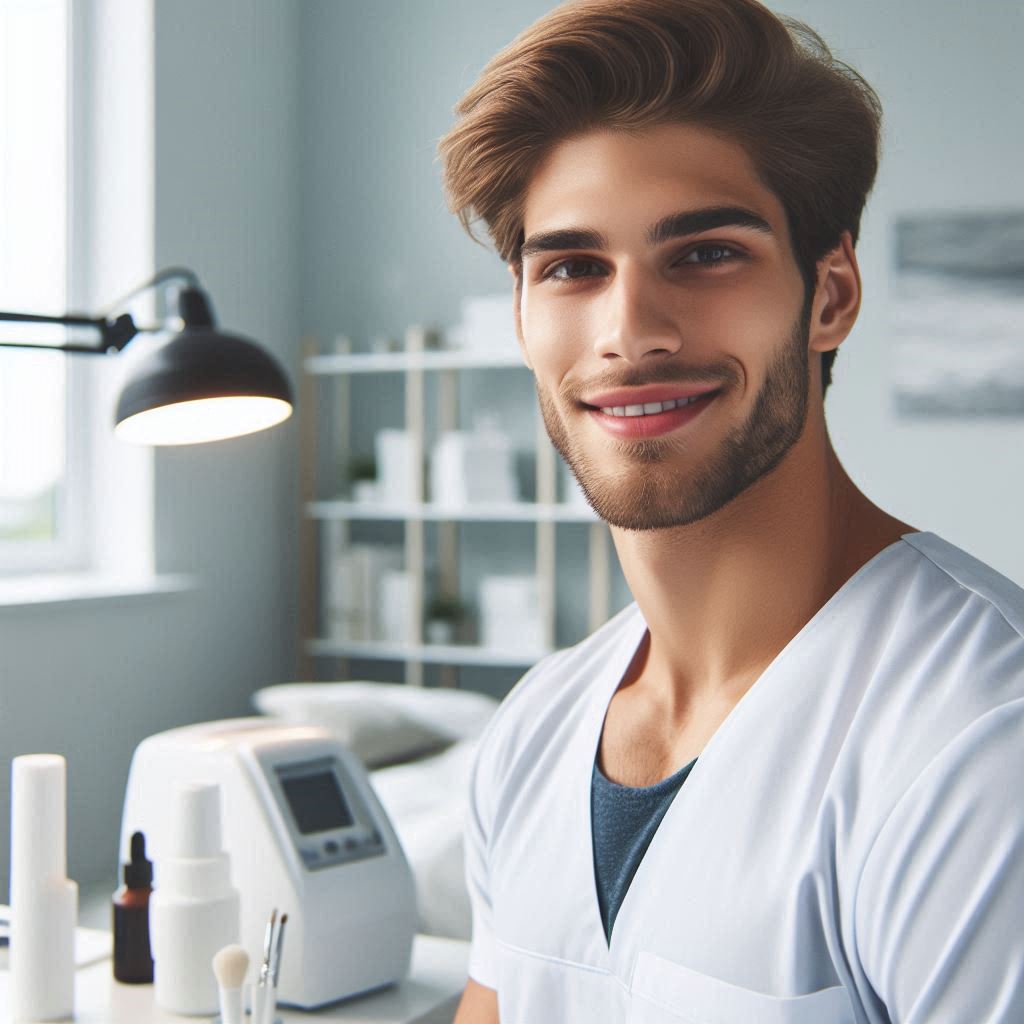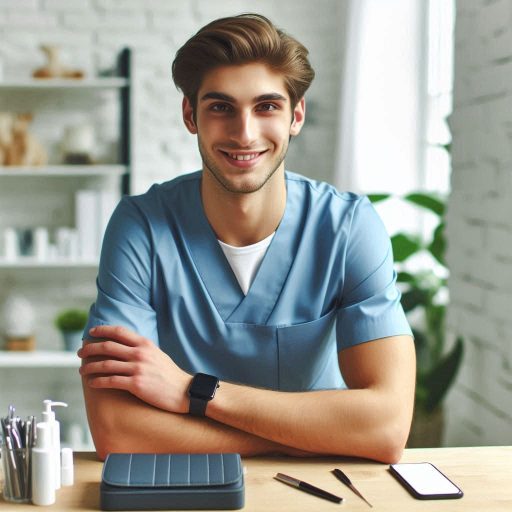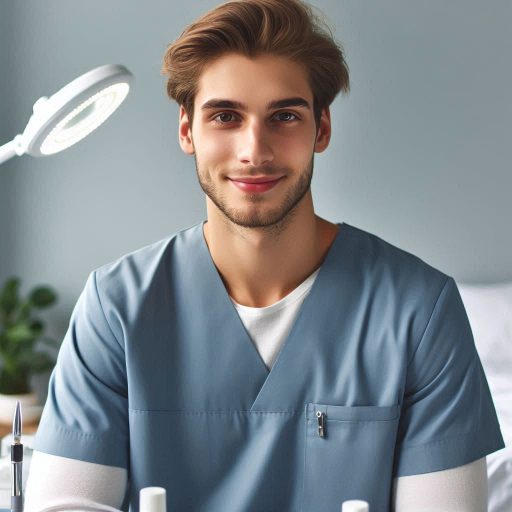Introduction
Understanding and mastering advanced esthetician techniques is crucial for professionals in the beauty industry.
These advanced techniques not only enhance the quality of esthetician services but also set professionals apart in a competitive market.
Microdermabrasion is a popular advanced esthetician technique that helps exfoliate and rejuvenate the skin by removing dead skin cells through mechanical exfoliation methods.
Chemical peels are another essential advanced technique that involves applying chemical solutions to the skin to improve texture, reduce fine lines, and even out skin tone.
Laser therapy is an advanced treatment that uses concentrated beams of light to target specific skin concerns such as acne scars, sun damage, and wrinkles, promoting collagen production.
Micro-needling is a technique that involves using a device with fine needles to create tiny punctures in the skin, triggering the body’s natural healing response and boosting collagen production.
High-frequency treatment involves using a high-frequency electrical current to treat various skin concerns like acne, fine lines, and wrinkles by promoting circulation and boosting collagen production.
LED light therapy is an advanced technique that utilizes different wavelengths of light to target specific skin concerns such as acne, inflammation, and aging, promoting skin healing and rejuvenation.
Mastering these advanced esthetician techniques will not only expand your service offerings but also enhance client satisfaction and loyalty, ultimately growing your esthetician business.
Chemical Peels
Chemical peels are a popular esthetic treatment that involves applying a chemical solution to the skin to exfoliate and improve its appearance.
Here is an explanation of what chemical peels are and how they work:
Explanation of Chemical Peels
Chemical peels work by removing the outermost layers of the skin, which stimulates cell renewal and helps improve skin texture and tone.
The type and strength of the peel will determine the depth of exfoliation.
Benefits of Chemical Peels
- Improves skin texture and tone
- Reduces the appearance of fine lines and wrinkles
- Helps with acne and acne scarring
- Stimulates collagen production
- Enhances overall skin radiance
Different Types of Peels and Their Strengths
There are several types of chemical peels available, ranging from superficial to deep peels.
Here are some common types and their strengths:
- Superficial Peel: Mild exfoliation, suitable for all skin types
- Medium Peel: Moderate exfoliation, targets deeper skin layers
- Deep Peel: Significant exfoliation, best for serious skin issues
Importance of Proper Training and Certification
Performing chemical peels requires specialized knowledge and training to ensure safe and effective results.
It is crucial for estheticians to undergo proper training and obtain certification before offering this treatment to clients.
In essence, chemical peels are a valuable esthetic technique that can help improve various skin concerns.
Understanding the different types of peels, their benefits, and the importance of proper training is essential for estheticians to provide optimal care for their clients.
Read: Benefits of Visiting an Esthetician Regularly
Transform Your Career Today
Unlock a personalized career strategy that drives real results. Get tailored advice and a roadmap designed just for you.
Start NowMicrodermabrasion
Microdermabrasion is a non-invasive cosmetic procedure used to exfoliate and rejuvenate the skin.
It works by removing the outermost layer of dead skin cells, revealing a smoother, more youthful complexion.
Benefits of Microdermabrasion
- Improves skin texture and tone
- Reduces the appearance of fine lines and wrinkles
- Helps with acne scarring and hyperpigmentation
- Stimulates collagen production for firmer skin
How Microdermabrasion Helps with Exfoliation and Skin Rejuvenation
Microdermabrasion uses a handheld device to gently exfoliate the skin with fine crystals or a diamond tip.
This process removes dead skin cells and promotes cell turnover, resulting in a fresh, radiant complexion.
It also stimulates blood flow to the skin, which can improve collagen and elastin production.
Techniques for Performing Microdermabrasion Safely and Effectively
- Start with a thorough cleansing of the skin to remove any dirt or makeup
- Choose the appropriate microdermabrasion device and settings for the client’s skin type
- Use gentle, even strokes to exfoliate the skin, avoiding sensitive areas like the eyes
- Follow up with a soothing mask or moisturizer to hydrate the skin post-treatment
Potential Side Effects and How to Manage Them
While microdermabrasion is generally safe, some clients may experience mild side effects such as redness, dryness, or sensitivity.
These effects are usually temporary and can be managed with the following tips:
- Avoid sun exposure and wear sunscreen to protect the skin
- Use gentle skincare products to avoid irritation
- Stay hydrated and moisturize the skin regularly
- Consult with a dermatologist if any persistent or severe reactions occur
Read: Esthetician Licensing Requirements by State
Microneedling
Microneedling is a popular procedure used for skin rejuvenation and improving the overall appearance of the skin.
Overview of Microneedling
Microneedling involves using a device with fine needles to create tiny punctures in the top layer of the skin.
These micro-injuries stimulate the body’s natural healing process, leading to increased collagen and elastin production.
Benefits of Microneedling for Skin Rejuvenation
One of the key benefits of microneedling is its ability to improve skin texture, tone, and overall appearance.
It can also reduce the appearance of fine lines, wrinkles, acne scars, and hyperpigmentation.
Stimulating Collagen Production
When the skin is punctured during microneedling, it triggers the production of collagen, a key protein responsible for skin elasticity.
Collagen helps to plump the skin and reduce the appearance of wrinkles and fine lines, resulting in a more youthful appearance.
Types of Microneedling Devices
There are different types of microneedling devices available, ranging from manual rollers to automated pens with adjustable needle lengths.
The effectiveness of these devices may vary, so it is essential to choose the right one based on your specific needs and skin concerns.
Precautions and Aftercare Tips
Before undergoing a microneedling treatment, it is crucial to consult with a qualified esthetician or dermatologist to assess your skin’s suitability.
After the treatment, it is essential to follow proper aftercare tips, such as avoiding direct sun exposure and using gentle skincare products to aid in the healing process.
By following these precautions and aftercare tips, you can maximize the results of your microneedling treatment and ensure long-lasting benefits for your skin.
Transform Your Career Today
Unlock a personalized career strategy that drives real results. Get tailored advice and a roadmap designed just for you.
Start NowRead: Popular Skincare Treatments by Estheticians

Laser Hair Removal
Introduction to Laser Hair Removal
Laser hair removal is a popular advanced esthetician technique that offers a long-term solution to unwanted hair.
It involves using a laser to target hair follicles, ultimately reducing hair growth.
How Laser Hair Removal Works
Laser hair removal works by emitting a concentrated beam of light that is absorbed by the melanin in the hair follicle.
This destroys the hair follicle, preventing further hair growth.
Benefits over Traditional Methods
Compared to traditional hair removal methods like shaving or waxing, laser hair removal offers longer-lasting results.
It is also less painful and can target specific areas more accurately.
Factors to Consider for Different Skin Types
When performing laser hair removal, it is crucial to take into account the client’s skin type.
Darker skin tones may require different settings to ensure effective and safe treatment.
Importance of Conducting a Patch Test
Prior to performing laser hair removal, it is essential to conduct a patch test on the client’s skin.
This helps to determine how their skin will react to the treatment and ensures their safety.
Read: Top Challenges Faced by Estheticians
LED Light Therapy
Explanation of LED light therapy and its skin benefits
LED light therapy has gained popularity in skincare for its numerous benefits.
This non-invasive treatment uses different wavelengths of light to target various skin concerns.
It helps improve skin tone, reduce fine lines, and enhance overall skin health.
The therapy stimulates cellular activity, promoting collagen production and healing.
Different colors of LED lights and their effects on the skin
Different colors of LED lights serve specific purposes.
Red light penetrates deeply, promoting collagen synthesis and reducing wrinkles.
Blue light targets acne-causing bacteria, helping to clear breakouts.
Green light works to lighten pigmentation and even out skin tone. Yellow light improves redness and boosts circulation.
Transform Your Career Today
Unlock a personalized career strategy that drives real results. Get tailored advice and a roadmap designed just for you.
Start NowUnderstanding these colors helps professionals tailor treatments to individual needs.
How to incorporate LED light therapy into skincare treatments
Incorporating LED light therapy into skincare treatments is straightforward.
First, cleanse the skin thoroughly to remove impurities.
Then, apply a suitable serum to enhance the effects of the therapy.
Position the LED device over the treatment area and select the appropriate light color.
Sessions typically last between 15 to 30 minutes, depending on the treatment goals.
Clients can enjoy the therapy as a standalone treatment or as part of a comprehensive skincare regimen.
Tips for maximizing the effectiveness of LED light therapy sessions
To maximize the effectiveness of LED light therapy sessions, follow some practical tips.
Encourage clients to remain consistent with their treatments, as results improve over time.
Recommend using LED therapy two to three times a week for optimal results.
Educate clients on the importance of proper skincare routines.
Hydrating the skin before and after treatments enhances benefits.
Lastly, advise clients to protect their skin from sun exposure post-treatment, as this helps maintain results.
In summary, LED light therapy offers advanced esthetician techniques that provide numerous skin benefits.
By understanding the different light colors and incorporating them into treatments, estheticians can deliver tailored skincare solutions.
High-Frequency Treatments
High-frequency treatments are a popular technique in the field of esthetics that utilize a high-frequency electrical current to treat various skin concerns.
These treatments are known for their ability to address acne, boost collagen production, reduce fine lines and wrinkles, and improve overall skin health.
Overview of High-Frequency Treatments
High-frequency treatments involve the use of a glass electrode filled with either neon or argon gas that emits a high-frequency current when in contact with the skin.
This current generates oxygen molecules and creates ozone, which helps to kill bacteria, reduce inflammation, and promote healing.
Benefits for the Skin
- Reduces acne: The antibacterial properties of high-frequency treatments help to kill acne-causing bacteria, reducing breakouts and preventing future flare-ups.
- Improves skin texture: By promoting circulation and increasing collagen production, high-frequency treatments can improve skin texture and tone, resulting in a smoother, more radiant complexion.
- Minimizes fine lines and wrinkles: The stimulation of collagen and elastin production can help with the appearance of fine lines and wrinkles, making the skin look firmer and more youthful.
How High-Frequency Devices Work
High-frequency devices work by producing a mild electrical current that generates heat and ozone when in contact with the skin.
Transform Your Career Today
Unlock a personalized career strategy that drives real results. Get tailored advice and a roadmap designed just for you.
Start NowThis heat and ozone then help to kill bacteria, reduce inflammation, and promote healing, making high-frequency treatments effective for treating acne and other skin concerns.
Techniques for Performing High-Frequency Treatments on Acne-Prone Skin
- Cleanse the skin thoroughly before starting the treatment to remove any dirt, oil, and makeup that could interfere with the effectiveness of the high-frequency device.
- Apply a conductive gel or serum to the skin to help the high-frequency current penetrate deeper and maximize the treatment’s benefits.
- Gently glide the high-frequency electrode over the skin in circular motions, focusing on areas prone to acne breakouts to kill bacteria and reduce inflammation.
- Adjust the intensity of the high-frequency device based on the client’s comfort level and the severity of their acne to ensure a safe and effective treatment.
Safety Precautions and Contraindications for High-Frequency Treatments
- Avoid using high-frequency treatments on clients with pacemakers or other electronic implants, as the electrical current could interfere with these devices and pose a risk to the client’s health.
- Do not use high-frequency treatments on clients with a history of epilepsy, seizures, or heart conditions, as the electrical current could trigger adverse reactions or complications.
- Always perform a patch test before applying high-frequency treatments to the entire face to check for any allergic reactions or sensitivities to the treatment.
- Adhere to the manufacturer’s guidelines for the use of high-frequency devices, including proper sanitation and maintenance to ensure the safety and effectiveness of the treatment.
Overall, high-frequency treatments are a valuable addition to an esthetician’s toolkit, offering numerous benefits for the skin and effectively addressing a wide range of skin concerns, especially acne.
By understanding how high-frequency devices work, mastering proper techniques, and following safety precautions, estheticians can harness the power of high-frequency treatments to help their clients achieve healthier, clearer, and more youthful-looking skin.
Oxygen Facials
When it comes to advanced esthetician techniques, oxygen facials are a popular choice among clients for their hydrating benefits and rejuvenating effects on the skin.
Introduction to Oxygen Facials
Oxygen facials involve the use of pure oxygen, along with essential vitamins and nutrients, to nourish and revitalize the skin.
This treatment is suitable for all skin types, including sensitive skin.
Hydrating Benefits for the Skin
Oxygen facials help to hydrate the skin by delivering a burst of oxygen directly to the epidermis, leaving it looking and feeling refreshed.
This boost of oxygen also helps to stimulate cell regeneration.
Improving Circulation and Collagen Production
One of the key benefits of oxygen facials is their ability to improve circulation in the skin, which can help to promote collagen production.
Collagen is essential for maintaining skin elasticity and firmness, making oxygen facials a great anti-aging treatment.
Delivering Oxygen Effectively
There are several techniques for delivering oxygen effectively during facials, including the use of a specialized oxygen machine or an oxygen-infused mask.
Estheticians should be trained in the proper use of these tools to ensure optimal results.
Customization for Different Skin Types
Estheticians can customize oxygen facials to address specific skin concerns, such as acne, dryness, or hyperpigmentation.
By adjusting the oxygen flow and incorporating targeted serums, they can tailor the treatment to meet the unique needs of each client.
Addressing Specific Skin Concerns
For clients with acne-prone skin, oxygen facials can help to kill acne-causing bacteria and reduce inflammation.
Those with dry or dehydrated skin can benefit from the intense hydration provided by oxygen therapy.
Oxygen facials are a versatile and effective treatment that can benefit clients of all skin types.
By understanding the hydrating benefits, circulation-boosting effects, and customization options for different skin concerns, estheticians can provide top-notch service to their clients.
Conclusion
As a recap, incorporating advanced esthetician techniques into skincare services is crucial for delivering exceptional results.
I encourage all estheticians to prioritize ongoing education and training in advanced techniques to stay ahead in the field.
Transform Your Career Today
Unlock a personalized career strategy that drives real results. Get tailored advice and a roadmap designed just for you.
Start NowMastering advanced esthetician techniques not only benefits clients with superior treatments but also empowers estheticians with confidence and expertise.




